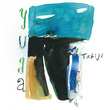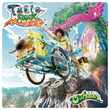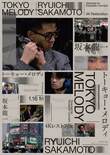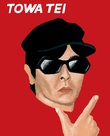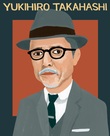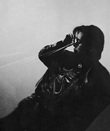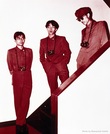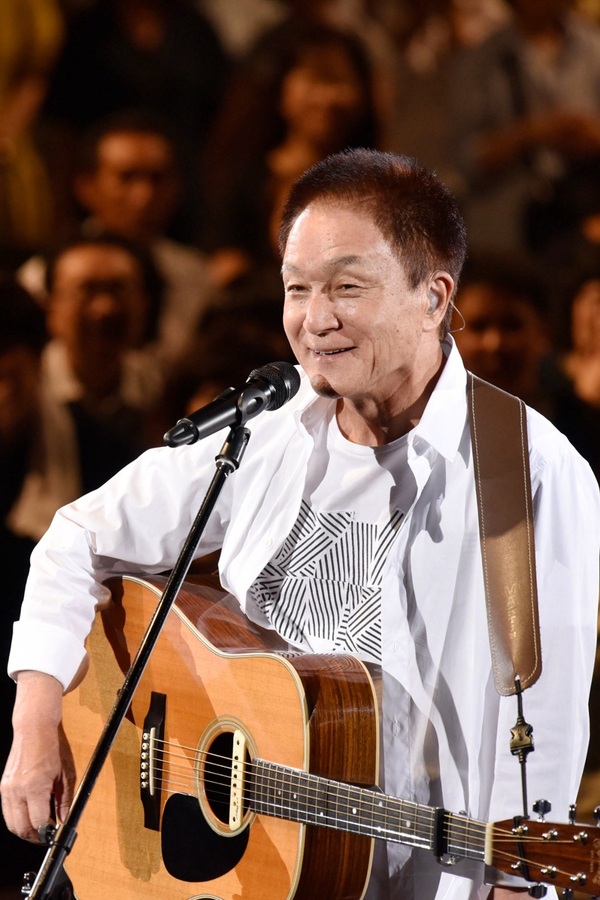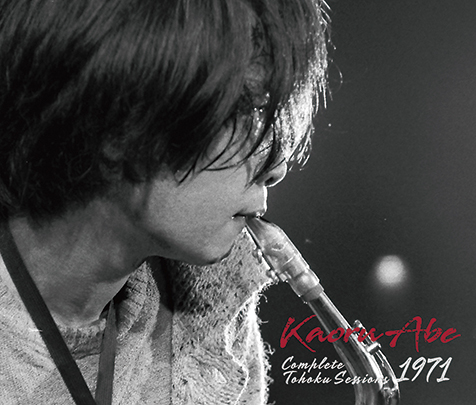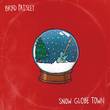TOWA TEI × Yoshinori Sunahara × Keigo Oyamada
(Interviewed and written by: Yu Onoda)
Keeping things hyper, METAFIVE is a band who still manages to stick to the adult aesthetic of 引きhiki (to be less represented, to eliminate any excess and concentrate on the essential quality, the art to stand back etc.) that is well-demonstrated in their solid tracks. As part of the trans-generation 6 piece who passes down to the music scene the electronic modernism now recognized as the flesh and blood of YMO, TOWA TEI, Keigo Oyamada and Yoshinori Oyamada talk about what METAFIVE is really about.
――I’ve heard that METAFIVE is a band that has three
TEI: “And Yukihiro-san is Bryan Ferry and LEO is David Byrne…”
Oyamada: “But Gon-chan (Tomohiko Gondo) is also a Brian Eno, so wouldn’t that make it the 4 of us, not 3?”
TEI: “No, no. Oyamada-kun is more of an Adrian Belew (guitarist of Talking Heads, The Tom Tom Club and King Crimson) (laugh).”
――Now that you say that, I’m now wondering what kind of band METAFIVE really is…
Sunahara: “Normally, having 3 Brian Enos in one band is simply not possible. It just won’t work!”
TEI: “Well, it’s not actual ‘Eno’s. Just three of us ‘wishing’ to be like him (laugh).”
――And I hear that what you had in mind when you got together as Yukihiro Takahashi & META-FIVE in 2014, was the reproduction of YMO’s synth-oriented [WINTER LIVE '81] (second national tour by YMO ran in ‘81), no?
Sunahara: “The members were originally gathered for the performance at the show, but at that time, Yukihiro-san suggested to ‘perform in a YMO-ish mode back then’. There were also other elements that played important parts for the embodiment of METAFIVE becoming a regular band, as exemplified in Yukihiro-san singing for the song “Radio” that was recorded in TEI-san’s 2013 album, “LUCKY”.”
TEI: “Even after the show, we worked together as Yukihiro Takahashi & METAFIVE to make the single track “Split Spirit” for Oyamada’s soundtrack of [Ghost in the Shell: ARISE|border:4 Ghost Stands Alone] in September of 2014, based on ideas given from Oyamada-kun. And working those steps up, we got into talking about making an album around last February. So we once got together to discuss over a meal, but couldn’t lay out anything specific. We did, at least, agree on changing the name of the group to ‘METAFIVE’, but no one knew what to say when we found out about the demo track Gon-chan alone had brought in (laugh).”
Sunahara: “That was like making a false start (laugh). But the mood when we were all listening to the demo was great, and there was something that convinced me that this was going to be something wonderful.”
TEI: “It’s not like we were starting from absolute zero. Having the experiences playing together at shows and co-working on tracks like “Radio” or “Split Spirit” made it easier for us to come up with new songs because we knew what to center the songwriting around. There were no restrictions to ideas, but we still did have the 2-songs-each quota to meet, so it was really helpful.”
Oyamada: “And there was this mutual understanding that Yukihiro-san and LEO-kun would be singing.”
TEI: “We all love the singing of those two, so even though we are a bunch who can normally write instrumental numbers, we ended up with the whole album made of songs that come with vocals.”
Sunahara: “So in that sense, it was easy for us to enter into the album production process.”
――Speaking about tracks, “Whiteout” sounds characteristically what Marin-san (Sunahara’s nickname) would make, given its style assumedly based on “LOVEBEAT” (album by Yoshinori Sunahara, 2001), but with the tracks “Luv U Tokio” and “Albore” made between TEI-san and Marin-san, it’s hard to tell straight off, who the main man was when making the track.”
Sunahara: “For “Luv U Tokio”, I was basically given the direction to ‘write something that can make for a lead track’. I did the underwork which then TEI-san gave a backbone to, and then I came back again giving concrete notes to it.”
TEI: “Alongside those works, I wrote the lyrics, and in an attempt to add content, I spent time at a coffee shop with LEO-kun. Meanwhile with “Albore”, I took the lead with Marin giving me the helping hand, and while usually I would give the finishing touches by myself if I were working solo, for this track, I intentionally left space and had LEO-kun fill in the lyrics. I think I was entrusting works to everyone. Perhaps the reason you can’t tell straight off (who did what), is because this METAFIVE-ish chemistry worked really well.”
Sunahara: “So basically, all of us were somehow involved in every song, but only TEI-san and myself have a few tracks that we took zero part in making. You were involved in every single song, right, Oyamada-kun?”
Oyamada: “There are tracks in which my involvement is very little, but yes, more or less.”
――In METAFIVE, you keep yourself strictly to a guitarist, Oyamada-san.
Oyamada: “I guess so. In my own album, I’d be the one adding all the electronic sounds myself, but in METAFIVE, that is also the expertise of many of the other members, so I figured out that, in this band, my position would be the guitarist.”
Sunahara: “Guitarhythm (laughs)!”
(“Guitarhythm”: Name of album by Tomoyasu Hotei, famous guitarist of disbanded rock band, BOØWY. Oyamada (as Cornelius) appears as guest artist on Hotei’s 30th anniversary album.)
――The track “Don’t Move” by Oyamada-san, that fully taps into the said ‘guitarhythm, plays out a totally renewed new-wave funk tune.’
Oyamada: “I kind of had in the back of my mind, what Marin was saying at the very beginning of production, -that something danceable would be nice’. I made a track that was over-energetic to use solo, but would be just perfect if sung by LEO-kun. I then passed that on to everybody. On the assumption that people will be adding sounds to it, I intentionally left some room, and even excluded the melody line I originally had in mind. And to that frame, TEI-sand and LEO-kun delivered the lyrics.”
――It goes without saying that Yukihiro-san is like YMO itself, but how do you position yourselves with respect to the YMO, because on hearing this album, the color of YMO doesn’t come striking?
TEI: “Both Marin and I have been publicly proclaiming that we entered into music via YMO, and Oyamada-kun had always been the wingman to YMO, so yes, YMO does get cited very frequently. It’s not like we don’t like having that said, but to make it clear, I don’t think METAFIVE is that conscious about YMO. What do you think?”
Sunahara: “No, we’re not. And maybe it’s a bit strange for me to say this, but having METAFIVE considered as a substitute for YMO isn’t necessary pleasant. That’s why I wanted to make our original tracks soon, and this time, I think we’ve made something truly METAFIVE-ish in our regular self, without having to hide what oozes out naturally.”
TEI: “I used to talk a lot with (Tomoo) Gokita who did the artwork for the cover this time, but there was this time that, perhaps due to the rudiments of ego, we would keep a certain distance from YMO, -like, the ‘age of delinquency’ (laughs).”
Sunahara: “Yup, totally happens!”
TEI: “For me that was around ‘87 when I went to NY. I didn’t bring any record I was listening to in Japan with me, and was thinking to myself that I’d only be listening to music of black artists. And even when I was thinking that way, DJs at the clubs would occasionally play YMO’s “Firecracker” or (Ryuichi Sakamoto’s) ”Riot In Lagos”. Basically, YMO is already part of our blood and flesh. Even for “Radio”, the melody and part of the lyrics that came to me when I was relaxing in a hot spring, was something that happened to remind me of Yukihiro-san, which was why I asked him to sing, but anyway, the song embraces this certain modern sound pressure seen in hip hop or the kitsch element in “Video Killed the Radio Star” by The Buggles, so all I can say is that, it’s not always about YMO.”
――In this piece, it doesn’t necessarily seem like you rustled up a whole formation of vintage synthesizers from back then, does it?
TEI: “Absolutely. However, including SKETCH SHOW (project by two of the three members of YMO) and HASYMO (by the three members of YMO, but considered as a combination of SKETCH SHOW and Ryuichi Sakamoto), the latest sounds of YMO and its surrounding has the image of being ‘static’, while METAFIVE is more the image of being ’dynamic’ as we originally formed for performing at live shows, and the music has a more physical appeal to it.”
Sunahara: “I think Yukihiro-san himself had been more on the side of ‘static’, but as well-expected, his playing in METAFIVE, that’s in the dynamic domain, is always great too.”
TEI: “It suits him well, doesn’t it? He is, in reality, a fairly tough guy, and he’s the one physically working away his muscles the most when he’s playing the drums.”
Oyamada: “Speaking of the “physical’ aspects of our music, having LEO, a much younger lad than us, served as a good traction for the band.”
Sunahara: “It was like we were being pulled forward, but there was also a part of us expecting him to do so. I think we were all working on the album while also thinking of the best way to get the most out of having LEO-kun in the band.”
TEI: “In that sense, there’s still a wide variation to enjoy in METAFIVE. Well, all of us have our hands full in each other’s own way, so there’s nothing fixed for the future. But actually, this indecisiveness, - I think that also is so precisely like this band, METAFIVE (laugh).”














